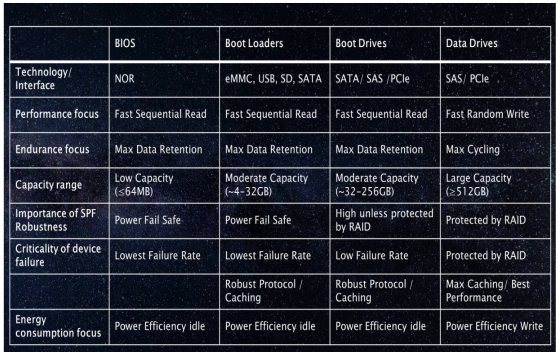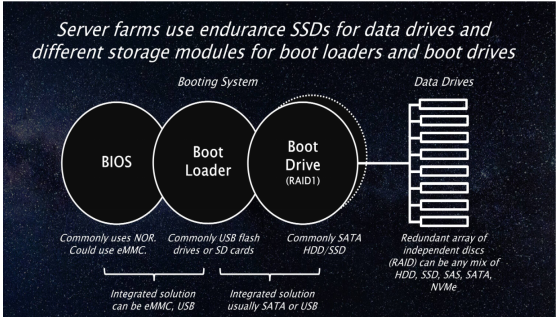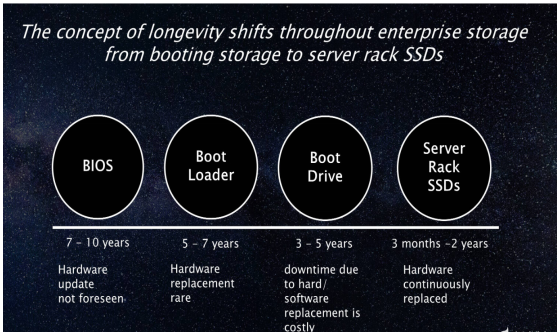Is the demand for the embedded enterprise version boot drive large?
Storage modules are an integral part of consumer, industrial and enterprise systems. The unique workload and challenges of these markets determine the design and components of the system. It is well known that storage systems designed for the corporate sector are very focused on achieving significant endurance rates. The server farm's rack server SSD is designed to achieve daily speed, low latency and maximum drive writes. Their performance should be second to none. However, while we are linking data centers to high-performance SSDs, we must admit that for the server to function properly, a second type of storage is required. Often overlooked, boot drives are critical to the success of these data cities.
The operating system and bootloader drives account for about 2% of the total number of enterprise storage solution drives. The boot drive is designed to ensure that the server is safely started and shut down under all conditions. Their use cases are unique because they don't start often, but when they do, they must be efficient and reliable. Their design requirements are completely different from the rack server SSDs that make up the mass storage portion of the server farm. Sometimes the bootloader is separate from the actual operating system and is usually in the form of a USB flash drive or SD card. Those who need to perform reliable processes to ensure safe and reliable startup, verify usage patterns and power down robustness in all situations. In other cases, the Boot SSD is used to support the boot loader and the operating system. These drives are often protected by RAID1.

The flash controller and FTL ensure that the system performs a complete optimization for its usage and unique workload. In addition, there is a significant difference in the controller requirements between the rack server SSD and the boot system.
Boot storage requirements compared to enterprise data drives.
The server farm is known for its enterprise durability SSD. However, their boot system contains more modules, including the BIOS (Basic IO System), the boot loader, and the boot drive. These have a unique set of requirements. Because the boot system acts as a gatekeeper for the server, these drives should be as reliable and secure as possible without affecting power failure or data retention issues. As the amount and value of processed data increases, the quality and reliability of the boot media also increases. The best system is just as good as the weakest part of the chain.

The BIOS (Basic Input Output System) has been stored on NOR until now to configure the basic boot function, configure the system and boot sequence. NOR seems to be appropriate because of the relatively small capacity requirements, the reliability of NOR and the good read/write speed of a small number of updates. However, alternative embedded storage media such as eMMC, eUSB or eSATA may be a reliable alternative to NOR combined BIOS, bootloader and base operating system. Bootloaders are typically stored in NAND flash-based USB drives and SD cards. The advantage of SD cards and USB flash drives for boot loaders is that they not only enable fast and safe boot, but also provide the necessary storage capacity that NOR does not have.
The boot drive that stores the OS requires more storage capacity. While it is not uncommon for bootloaders and drives to run on two different media, some manufacturers have begun to connect these two processes in a single, more reliable solution. NAND-based solutions have been widely used for boot loaders and boot drives. However, what is often overlooked is the function of the flash controller and its role in managing and optimizing the boot system. A reliable startup process is the key to the operation of the data center. The quality and performance specifications of flash media and controllers should be the primary discussion of such system architectures.
Swap space and its need for a reliable foundation
Exchange space is often overlooked and is an area of the server that requires a solid foundation. The swap space requires some storage, usually part of the boot drive. When the RAM demand is high, this space will be reserved for the operating system to be used as an overflow.
Since the server does not restart too often, most read/write usage on the boot drive is usually performed by a memory swap. This means that increasing the speed will also increase the performance of the server with heavy load. As enterprise departments are paying more and more attention to performance, the demand for RAM in servers is high. This in turn makes the swap space an indispensable and growing part of the server that needs to be properly considered. In addition to meeting the requirements for fast start-up, authentication, security, and power-down security, memory swapping in the server requires reliability to be considered when designing the boot drive.
The importance of flash controllers in NAND-based boot storage.
When it comes to booting with NAND flash-based modules, the chosen flash controller is very important because it determines the reliability and speed of the entire process. RAID can be a solution to achieve reliability. Industrial-grade flash controllers and systems add value and reliability and are perfectly tuned to optimize the boot process. The controller can enable a secure authentication process and tamper-proof measures to ensure that the operating system is not compromised. The controller can enable a variety of security features such as secure boot, redundant firmware, authorized in-place firmware update, device binding, anti-cloning, write protection, confidentiality and data integrity checks.

While fast boot, authentication and security are critical in booting the drive, the most important requirement is the power down security under all conditions. Typically, RAID1 and mirrored boot drives ensure a certain level of reliability. However, accidentally shutting down the system can still have serious consequences for drives that are not prepared or designed to handle such processes. Data may be lost, and in the worst case, it may be the backbone of the server - the operating system. Finally, the failed drive needs to be replaced to increase service costs. Because the boot system manages the operation of many other drives, their reliability is greatly limited and should be as robust as possible. Flash controllers are like the brain and have different levels of IQ. This means that controller vendors can handle significant differences in power consumption compared to another controller vendor. Booting requires first-class power-down management to ensure that the server is not compromised in the event of a power outage.
Why should there be more discussion about the life of enterprise storage?
Durability and longevity are major issues in the industry. In some cases, storage systems must be implemented for more than a decade, and compatible replacement drives must be used for legacy interfaces for extended periods of time. In order to recertify and minimize software migration costs, consider the longevity of boot drives over data drives and the durability and longevity of some server systems. The purchase of industrial-grade flash memory systems not only enables the necessary safe and reliable boot process, authentication and power-down robustness, but also ensures longer and more stable system life.
The overall enterprise is known for its performance requirements, but the reliability requirements of its startup system are often overlooked. The bootloader is an important part of enterprise storage and must be designed to safely start and shut down the server. They must ensure a safe boot and do not compromise the operating system and data due to accidental power loss. The key component in the storage system that ensures that the storage module is fully optimized to boot storage is the flash controller. Flash controllers vary by vendor. While some manufacturers design controllers that are ideal for consumer storage, Hyperstone is focused on industrial-grade flash controllers and is ideal for booting storage in enterprise server rooms.
If you want to know more, our website has product specifications for embedded, you can go to ALLICDATA ELECTRONICS LIMITED to get more information

